Lockheed T-33
The Lockheed T-33 Shooting Star (or T-Bird) is a subsonic American jet trainer. It was produced by Lockheed and made its first flight in 1948. The T-33 was developed from the Lockheed P-80/F-80 starting as TP-80C/TF-80C in development, then designated T-33A. It was used by the U.S. Navy initially as TO-2, then TV-2, and after 1962, T-33B. The last operator of the T-33, the Bolivian Air Force, retired the type in July 2017, after 44 years of service.[1]
| T-33 Shooting Star | |
|---|---|
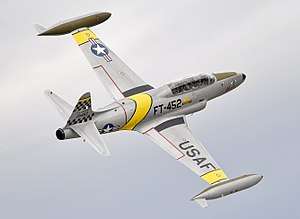 | |
| A demonstration T-33 in flight in 2016 | |
| Role | Training aircraft |
| Manufacturer | Lockheed |
| Designer | Clarence "Kelly" Johnson |
| First flight | 22 March 1948 |
| Retired | 31 July 2017 (Bolivian Air Force) |
| Primary users | United States Air Force United States Navy Japan Air Self Defense Force German Air Force |
| Produced | 1948–1959 |
| Number built | 6,557 |
| Developed from | Lockheed P-80 Shooting Star |
| Variants | Lockheed T2V SeaStar Canadair CT-133 Silver Star |
| Developed into | Lockheed F-94 Starfire Boeing Skyfox |
Design and development
The T-33 was developed from the Lockheed P-80/F-80 by lengthening the fuselage by slightly more than 3 feet (1 m) and adding a second seat, instrumentation, and flight controls. It was initially designated as a variant of the P-80/F-80, the TP-80C/TF-80C.[2]
Design work on the Lockheed P-80 began in 1943, with the first flight on 8 January 1944. Following on the Bell P-59, the P-80 became the first jet fighter to enter full squadron service in the United States Army Air Forces. As more advanced jets entered service, the F-80 took on another role—training jet pilots. The two-place T-33 jet was designed for training pilots already qualified to fly propeller-driven aircraft.
Originally designated the TF-80C, the T-33 made its first flight on 22 March 1948 with Lockheed test pilot Tony LeVier at the controls. Production at Lockheed ran from 1948 to 1959. The US Navy used the T-33 as a land-based trainer starting in 1949. It was designated the TV-2, but was redesignated the T-33B in 1962. The Navy operated some ex-USAF P-80Cs as the TO-1, changed to the TV-1 about a year later. A carrier-capable version of the P-80/T-33 family was subsequently developed by Lockheed, eventually leading to the late 1950s to 1970s T2V-1/T-1A SeaStar. The two TF-80C prototypes were modified as prototypes for an all-weather two-seater fighter variant, which became the F-94 Starfire. A total of 6,557 T-33s were produced: 5,691 of them by Lockheed, 210 by Kawasaki, and 656 by Canadair.
Operational history
U.S. Air Force and U.S. Navy
The two-place T-33 proved suitable as an advanced trainer, and it has been used for such tasks as drone director and target towing. The U.S. Air Force began phasing the T-33 out of front-line pilot training duties in the Air Training Command in the early 1960s, as the Cessna T-37 Tweet and Northrop T-38 Talon aircraft began replacing it for the Undergraduate Pilot Training (UPT) program. The T-33 was used to train cadets from the Air Force Academy at Peterson Field (now Peterson Air Force Base in Colorado Springs). The T-37 replaced the T-33 for Academy training in 1975. The final T-33 used in advanced training was replaced 8 February 1967 at Craig AFB, Alabama.[3] Similar replacement also occurred in the U.S. Navy with the TV-1 (also renamed T-33 in 1962), as more advanced aircraft such as the North American T-2 Buckeye and Douglas TA-4 Skyhawk II came on line. USAF and USN versions of the T-33 soldiered on into the 1970s and 1980s with USAF and USN as utility aircraft and proficiency trainers, with some of the former USN aircraft being expended as full-scale aerial targets for air-to-air missile tests from naval aircraft and surface-to-air missile tests from naval vessels. Several T-33s were assigned to USAF McDonnell F-101 Voodoo, Convair F-102 Delta Dagger, and Convair F-106 Delta Dart units, to include similarly equipped Air National Guard units, of the Aerospace Defense Command as proficiency trainers and practice "bogey" aircraft. Others later went to Tactical Air Command, and TAC gained Air National Guard F-106 and McDonnell-Douglas F-4 Phantom II units in a similar role until they were finally retired, with the last being an NT-33 variant retired in April 1997.
Military use by other nations
Some T-33s retained two machine guns for gunnery training, and in some countries, the T-33 was even used in combat: the Cuban Air Force used them during the Bay of Pigs Invasion, scoring several kills. The RT-33A version, reconnaissance aircraft produced primarily for use by foreign countries, had a camera installed in the nose and additional equipment in the rear cockpit. T-33s continued to fly as currency trainers, drone towing, combat and tactical simulation training, "hack" aircraft, electronic countermeasures, and warfare training and test platforms right into the 1980s.
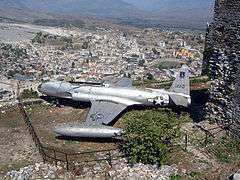
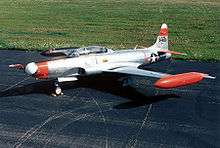
The T-33 has served with over 30 nations and continues to operate as a trainer in smaller air forces. Canadair built 656 T-33s on licence for service in the RCAF—Canadian Forces as the CT-133 Silver Star, while Kawasaki manufactured 210 in Japan. Other operators included Brazil, Turkey, and Thailand, which used the T-33 extensively.
In the 1980s, an attempt was made to modify and modernize the T-33 as the Boeing Skyfox, but a lack of orders led to the project's cancellation. About 70% of the T-33's airframe was retained in the Skyfox, but it was powered by two Garrett AiResearch TFE731-3A turbofan engines.
In the late 1990s, 18 T-33 Mk-III and T-33 SF-SC from the Bolivian Air Force went to Canada to be modernized at Kelowna Flightcraft. New avionics were installed, and detailed inspection and renewal of the fuselage and wings were performed. Most of the aircraft returned in early 2001 and remained operational until the type was officially retired on 31 July 2017.[4]
On 21 June 1996, 1 T-33A-5-LO (trainer TR-602) from the Hellenic Air Force piloted by Squadron Leader Ioannis Kouratzoglou successfully intercepted a Turkish F-16C violating Athens FIR by engaging in low-altitude high-G maneuvers.[5]
Civilian use
A limited number of T-33s have been owned privately, with two used by Boeing as chase aircraft. In 2010, one T-33 owned by Boeing was used as a chase aircraft during the maiden flight of the Boeing 787.[6] The maiden flight of the Boeing 737 MAX-7 on 16 March 2018 also featured a T-33 chase plane.[7] The maiden flight of the Boeing 777-9 on January 25th 2020 also featured a T-33 chase plane, taking off from KBFI and meeting the 777-9 at KPAE, it stopped at KMWH and it took off again to chase the 777-9 on its way back to KBFI, flying around Mount Rainier before their landing.[8] Actor and pilot Michael Dorn owned a T-33.[9]
Variants
- TP-80C
- Original United States military designation for the Lockheed Model 580 two-seat trainer for the United States Army Air Forces. Designation changed to TF-80C on 11 June 1948 following establishment of the United States Air Force as a separate military service in 1947, and then to T-33A on 5 May 1949; 20 built.
- T-33A
- Two-seat jet trainer aircraft for the United States Air Force and delivery to foreign air forces under the Military Assistance Program, 5871 including 699 diverted to the United States Navy as the TV-2.
- AT-33A
- Conversions of the T-33A for export as a close support variant fitted with underwing pylons and hard points for bombs and rockets. Also used in the original fighter lead-in program at Cannon AFB, NM approximately 1972- 1975.
- DT-33A
- This designation was given to a number of T-33As converted into drone directors.
- NT-33A
- This designation was given to a number of T-33As converted into special test aircraft.
- QT-33A
- This designation was given to number of T-33As converted into aerial target drones for the United States Navy.
- RT-33A
- T-33A modified before delivery as a single-seat reconnaissance variant; 85 built, mainly for export under the Military Assistance Program.
- T-33B
- Re-designation of the United States Navy TV-2 in 1962.
- DT-33B
- Re-designation of the United States Navy TV-2D drone director in 1962.
- DT-33C
- Re-designation of the United States Navy TV-2KD target in 1962
- TO-1/TV-1
- U.S. Navy designation of P-80C, 50 transferred to USN in 1949 as jet trainers (not technically T-33 Shooting Star)
- TO-2
- United States Navy designation for 649 T-33As diverted from USAF production. Two-seat land-based jet training aircraft for the U.S. Navy. First 28 were delivered as TO-2s before the Navy changed the designation to TV-2. Surviving United States Navy and United States Marine Corps aircraft were re-designated T-33B on 18 September 1962.[10]
- TV-2
- Re-designation of the TO-2 after the first 28 were built.
- TV-2D
- TV-2s modified as drone directors, later re-designated DT-33B.
- TV-2KD
- TV-2s modified as radio-controlled targets, could be flown as a single-seater for ferry, later re-designated DT-33C.
Canada
- Silver Star Mk 1
- Canadian-designation for T-33A, 20 delivered.
- Silver Star Mk 2
- Canadian-designation for a T-33A which became the prototype of the Silver Star Mk 3.
- T-33AN/CT-133 Silver Star Mk 3
- The T-33AN is a Rolls-Royce Nene powered-variant of the T-33A for the Royal Canadian Air Force; 656 built by Canadair with the company designation CL-30. Canadian military designation was later changed from T-33AN to CT-133.
Other
- L-245
- One Lockheed owned fuselage with a more powerful engine. Was later developed into the T2V SeaStar.[11]
- Aérospatiale Pégase[12]
- A Canadair T-33AN was modified by Aérospatiale with an S17a 17% thickness wing section.
- Boeing Skyfox
- A comprehensive upgrade and re-engine project, powered by 2 Garrett TFE-731 turbofans. The sole prototype remains parked, sans engines, at Rogue Valley International (MFR) at Medford, Oregon.
Former operators
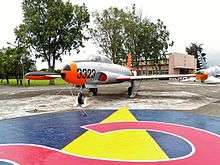
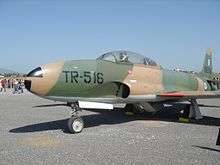
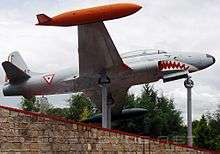
.jpg)
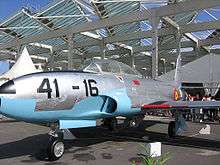
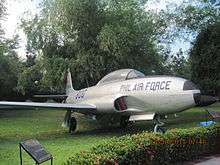
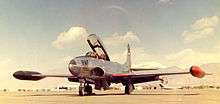
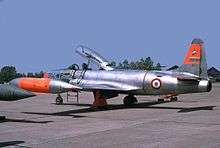

For operators of Canadian-built aircraft refer to Canadair CT-133 Silver Star.
- Belgian Air Force (38 × T-33A, 1 × RT-33A operated from 1952)
- Bolivian Air Force - Bolivia acquired 15 T-33AN from Canada in 1973–74, purchasing 5 more from Canada in 1977 and 18 T-33SFs from France in 1985.[13] 18 were upgraded to T-33-2000 standard in 2000–2001.[14] Retired in 2017.[15]
- Burmese Air Force – 15 x AT-33A for use as trainers and close air support.[16]
- Royal Canadian Air Force
- Royal Canadian Navy
- Canadian Forces
- National Research Council
- Cuban Air Force
- Dominican Air Force – AT-33A
- Ecuadorian Air Force – AT-33A
- French Air Force – 163 x T-33A and RT-33A (also 61 Canadian-built T-33AN)
- German Air Force 192 x T-33A
- Hellenic Air Force – T-33A, RT-33A, and Canadian-built AT-33ANs
- Honduran Air Force – T-33A and RT-33A
- Indonesian Air Force – T-33A
- Imperial Iranian Air Force
- Islamic Republic of Iran Air Force
- Italian Air Force operated 60 Lockheed T-33A and 14 Lockheed RT-33A from 1952 until 1982[18]

- Japan Air Self Defense Force T-33A – assembled and later manufactured by Kawasaki Heavy Industries Aerospace Company from 1956.[19]
- Tactical Fighter Training Group (1981–1992)
- 3rd Tactical Fighter Squadron (1956–1992)
- 6th Tactical Fighter Squadron (1959–1992)
- 8th Tactical Fighter Squadron (1959–1992)
- 201st Tactical Fighter Squadron (1963–1974, 1986–1994)
- 202nd Tactical Fighter Squadron (1964–1992)
- 203rd Tactical Fighter Squadron (1964–1992)
- 204th Tactical Fighter Squadron (1964–1993)
- 301st Tactical Fighter Squadron (1973–1993)
- 302nd Tactical Fighter Squadron (1974–1994)
- 303rd Tactical Fighter Squadron (1976–1994)
- 304th Tactical Fighter Squadron (1977–1993)
- 305th Tactical Fighter Squadron (1978–1993)
- 306th Tactical Fighter Squadron (1981–1994)
.svg.png)
- Libyan Arab Air Force – T-33A
- Mexican Air Force – 50 units AT-33A
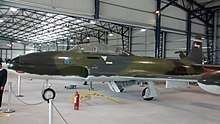 T-33 of the Uruguayan Air Force
T-33 of the Uruguayan Air Force
- Royal Netherlands Air Force – 60 × T-33A, 3 × RT-33A
- Nicaraguan Air Force FAN received delivery of four AT-33A aircraft from the US Government after the failed Bay of Pigs invasion in 1961. Retired from service in 1979.
- Pakistan Air Force – T-33A, RT-33A
- Paraguayan Air Force operated six AT-33A donated by Taiwan in 1990. The belonged to the Grupo Aerotáctico (GAT) 2nd. Fighter Squadron called "Indios". They were withdrawn from use in 1998.
- Portuguese Air Force T-33A and one RT-33A (all retired)
- Republic of Singapore Air Force: 12 x Former French Air Force T-33A delivered in 1980, followed by 8 more in 1982.[20]
- Republic of Korea Air Force: T-33A is First introduction Time: August, 1955. It also served with the ROKAF Black Eagles aerobatic team
- Spanish Air Force – 60 × T-33A
- Turkish Air Force – T-33A and RT-33A
- Boeing Commercial Airplanes (two Canadair CT-133 Silver Stars, N109X and N416X)[21]
- United States Air Force
- United States Navy
- United States Marine Corps[10]
- Uruguayan Air Force – 8 × AT-33A[22]
- Yugoslav Air Force – Operated 125 Shooting Stars in four variants: 25 T-33A, 22 RT-33A, 70 TV-2, and 8 TT-33A[23]
Aircraft on display
Numerous T-33s have been preserved as museum and commemorative displays.
Notable accidents and incidents
- 10 August 1955
- A T-33 Air Force Jet Trainer crashed on a farm 10 miles southeast of Terre Haute IN. Capt. Lee Jetton and 1st Lt. Harry Sawyer Hall were killed. The plane was en route from Maxwell AFB, AL to Chanute AB, IL. The plane was reported to have exploded before crashing in a cornfield a quarter of a mile east of route 159. [24]
- 20 May 1958
- An Air National Guard Lockheed T-33A was involved in a mid-air collision with Capital Airlines Flight 300, a Vickers Viscount, over Brunswick, Maryland.
- 23 November 1963
- A Royal Canadian Navy (RCN) Canadair CT-133 Silver Star on a naval training flight with two crew members on board, crashed into the heavily forested mountainous area of Mount Strachan in what is now known as Cypress Mountain. The two RCN crew members were killed.[25]
- 27 July 1965
- A United States Air Force (USAF) Lockheed T-33A crashed near Allenspark, Colorado while flying low and slow near a thunderstorm to check out newly purchased land. Both occupants, Major Jay. E. Currie and 1st Lt. Donald Darby, were killed.[26][27]
- 20 August 1971
- Matiur Rahman was an instructor pilot at PAF Base Masroor in 1971.[28] He was planning to defect to India with a plane to join the Bangladesh Liberation War. On 20 August 1971, Pilot Officer Rashid Minhas was scheduled to fly with a Lockheed T-33 jet trainer. Rahman saw Minhas about to take off and asked to join him, he jumped into the instructor seat.[29] He attempted to hijack the T-33 in midair from Karachi, Pakistan to India to join the liberation movement. Minhas sent a message to control tower that he has been hijacked. Minhas wrestled with Rahman for control and crashed the plane in Pakistan's territory which caused the death of both pilots. The plane never crossed into India's airspace and crashed near the border but in Pakistan.[30]
Specifications (T-33A)
Data from Lockheed Aircraft since 1913[31]
General characteristics
- Crew: 2
- Length: 37 ft 9 in (11.51 m)
- Wingspan: 38 ft 10.5 in (11.849 m)
- Height: 11 ft 8 in (3.56 m)
- Wing area: 234.8 sq ft (21.81 m2)
- Airfoil: NACA 65-213[32]
- Empty weight: 8,365 lb (3,794 kg)
- Gross weight: 12,071 lb (5,475 kg)
- Max takeoff weight: 15,061 lb (6,832 kg)
- Powerplant: 1 × Allison J33-A-35 centrifugal flow turbojet engine, 5,400 lbf (24 kN) thrust for take-off with water injection
- 4,600 lbf (20,461.82 N) maximum continuous, dry
Performance
- Maximum speed: 600 mph (970 km/h, 520 kn) at sea level
- Cruise speed: 455 mph (732 km/h, 395 kn)
- Range: 1,275 mi (2,052 km, 1,108 nmi)
- Service ceiling: 48,000 ft (15,000 m)
- Rate of climb: 4,870 ft/min (24.7 m/s)
Armament
- Hardpoints: 2 with a capacity of 2,000 lb (907 kg) of bombs or rockets (AT-33),
See also
Related development
- Boeing Skyfox
- Canadair CT-133 Silver Star
- Lockheed F-94 Starfire
- Lockheed P-80 Shooting Star
- Lockheed T2V/T-1A Seastar
Aircraft of comparable role, configuration and era
Related lists
References
- "Fuerza Aérea desactiva cuatro aviones de entrenamiento y ataque T-33 – Diario Pagina Siete" (in Spanish). Retrieved 2017-07-31.
- Lockheed P-80/F-80 Archived 2007-12-19 at the Wayback Machine
- Scholin, Allan R., "Aerospace World", Air Force and Space Digest, Air Force Association, Washington, D.C., March 1967, volume 50, number 3, page 38.
- "Los aviones de entrenamiento y ataque T-33 de la FAB dejan de operar en Bolivia" (in Spanish). La Razón. 31 July 2017. Retrieved 31 July 2017.
- Πτηση & Διαστημα (2019-03-18). "Ελληνικό Τ-33 εναντίον τουρκικού F-16 – και δεν είναι βιντεοπαιχνίδι". Πτήση & Διάστημα (in Greek). Retrieved 2019-06-26.
- "787 First Flight from the chase plane." wired.com. Retrieved: 22 April 2010.
- "PHOTOS: Boeing's Smallest Modern 737, the MAX 7, Takes its First Flight". AirlineReporter. Retrieved 2018-10-02.
- "N109X Live Flight Tracking and History (T33 owned by BOEING LOGISTICS SPARES INC) ✈ 25-Jan-2020 ✈ KMWH - KBFI ✈ FlightAware". FlightAware. 25 January 2019. Retrieved 2020-01-27.
- Freeze, Di. "Michael Dorn: A Trek worth Remembering". Airportjournals.com. Airport Journals. Retrieved June 13, 2015.
- Jansen, Clay. " US Marine Corps Lockheed T-33 Shooting Star." Cloud 9 Photography, October 1961. Retrieved: 6 August 2013.
- Beck, Simon. "Lockheed Shooting Star Series" Archived 2011-05-21 at the Wayback Machine. US Warplanes.net. Retrieved: 21 October 2011.
- Gaillard, Pierre (1991). Les Avions Francaisde 1965 a 1990 (in French). Paris: Editions EPA. ISBN 2-85120-392-4.
- Siegrist 1987, p. 175.
- International Air Power Review Summer 2001, p. 28.
- Wasserbly, Daniel; Olguin, Jonathan R (1 August 2017). "Bolivia retires last T-33s trainer/attack aircraft, announces replacement". IHS Jane's 360. Archived from the original on 1 August 2017. Retrieved 1 August 2017.
- Andrade 1982, p. 35
- Schrøder, Hans (1991). Royal Danish Airforce. Ed. Kay S. Nielsen. Tøjhusmuseet, 1991, p. 1–64. ISBN 87-89022-24-6.
- "Lockheed RT 33". Aeronautica Militare. Retrieved 29 May 2019.
- "History of the Kawasaki Aerospace Division." Archived 2010-08-03 at the Wayback Machine Kawasaki Heavy Industries, Ltd. Retrieved: 21 March 2010.
- Pocock 1986, p. 92.
- "Aircraft Enquiry: N109X". FAA Registry. Retrieved: 11 Mar 2012.
- Andrade 1982, p. 336.
- "Letelice Lockheed T-33A, RT-33A i TV-2 u JRV i njihove sudbine" (in Croatian). paluba.info. Retrieved 23 December 2014.
- "T33 trainer. Two people in plane Capt. Lee Jetton". The Decatur Herald. 1955-08-11. p. 7. Retrieved 2020-01-20.
- "Cypress Mountain - T-33 Crash Site". 23 September 2016. Archived from the original on 2017-07-28. Retrieved 2017-07-28.
- "Allenspark T-33". coloradowreckchasing.com.
- "TrailDamage.com".
- "August 20 marks the death anniversary of Rashid Minhas". The Nation. 20 August 2014. Retrieved 19 June 2015.
- "42nd Martyrdom Anniversary Pilot Officer Rashid Minhas Shaheed [Nishan-e-Hyder.] – SFP News". www.shaheedfoundation.org. Retrieved 3 January 2016.
- "Rashid Minhas 39th death anniversary observed today". AAJ News. APP. Retrieved 3 January 2016.
- Francillon 1982, pp. 287, 293.
- Lednicer, David. "The Incomplete Guide to Airfoil Usage". m-selig.ae.illinois.edu. Retrieved 16 April 2019.
Bibliography
- Baugher, Joe. "Lockheed P-80/F-80." USAF Fighters. Retrieved: 11 June 2011.
- Davis, Larry. P-80 Shooting Star. T-33/F-94 in action. Carrollton, Texas: Squadron/Signal Publications, 1980. ISBN 0-89747-099-0.
- Dorr, Robert F. "P-80 Shooting Star Variants". Wings of Fame Vol. 11. London: Aerospace Publishing Ltd., 1998. ISBN 1-86184-017-9.
- Francillon, René J. Lockheed Aircraft since 1913. London: Putnam, 1982. ISBN 0-370-30329-6.
- "Fuerza Aérea Boliviana". International Air Power Review. Volume 1, Summer 2001. pp. 28–31. ISSN 1473-9917.
- Gaillard, Pierre (1991). Les Avions Français 1965 a 1990. Paris: Editions EPA. ISBN 2-85120-392-4.
- Hiltermann, Gijs. Lockheed T-33 (Vliegend in Nederland 3) (in Dutch). Eindhoven, Netherlands: Flash Aviation, 1988. ISBN 978-90-71553-04-2.
- Hoyle, Craig. "World Air Forces 2015". Flight International, 8–14 December 2015, Vol. 188, No. 5517. pp. 26–53. ISSN 0015-3710.
- Pace, Steve. Lockheed Skunk Works. St. Paul, Minnesota: Motorbooks International, 1992. ISBN 0-87938-632-0.
- Pocock, Chris. "Singapore Sting". Air International, Vol. 31, No. 2. pp. 59–64, 90–92.
- Siegrist, Martin. "Bolivian Air Power — Seventy Years On". Air International, Vol. 33, No. 4, October 1987. pp. 170–176, 194. ISSN 0306-5634.
External links
| Wikimedia Commons has media related to T-33 Shooting Star. |